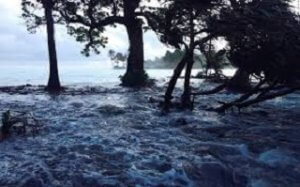From Guest Blogger Bobbi Peterson: The Relationship Between Climate Change and Natural Disasters

That question is a bit harder to answer. To start, we need to understand what the current impact of climate change is and what it will become in the future. Understanding the way the warming climate will modify the weather patterns and impact environments, as well as predict the risks is the new goal.
Why Knowledge is Power
The problem with this goal is that most people don’t understand how climate change works. At this point, most people don’t even know how a meteorologist gets a seven-day forecast, let alone a 100-year global impact on a changing climate. But just because you or others around you don’t understand it doesn’t mean climate change can’t occur.
After all, this isn’t the first time the Earth has gotten warmer. We can “look” back in time to see how flora and fauna reacted to the climate, and we can take what we know about the weather and storms now, and transfer that to the future with a variety of computer programs.
Plus, we now have a network of satellites that can help us track storms from orbit and monitor the environmental changes that impact them.
What is Basic Meteorology
Precipitation occurs when a warm front meets a cold front. The warmer air usually carries the humidity needed to create the rain and the colder air forces that hot air up higher where it can condense into clouds and fall. This process is the general idea of how and why storms form.
What Can Happen?
Most people know that climate change equates to rising sea levels. What fewer people understand is what, exactly, a warmer climate means. A few factors go into it but think about the tropics. It’s hot and steamy, rains often and storms sometimes. When the gales come, they’re often more severe.
A warming climate means that the rest of the world is going to become more like the tropics. While temperatures will increase, so will humidity, and that’s where the problems start to come in. The more humidity that’s available in an area, the better the chance of producing a severe storm.
The other factor then is the cold fronts. With the global temperature rising, cold fronts will become less common. This absence of cold fronts leads to a strange effect where storms are probably going to become less common, but when they do hit they have the potential to be much more severe.
A few studies predict this phenomenon, including one that claims coastal flooding could double by 2050. That’s much sooner than most predictions, and the report is pretty astonishing as it’d have a severe impact on some American coastal cities that are prone to flooding, including Baltimore, Philadelphia and Washington D.C. among others.
What Do Natural Disasters Have to Do With It?
Natural disasters aren’t just limited to volcanic eruptions and earthquakes. Hurricanes, monsoons, droughts, tornados, floods and mudslides are all part of natural disasters, and they’re all related to weather patterns.
Drought seasons could get longer and more intense. We’ve already seen what the raging wildfires in California have done the past few years, and an extended drought season would only make it worse. Once the land is entirely dried out, and a severe storm does hit, the water will wash off. The influx of rain could create massive mudslides, flooded rivers and sinkholes.
Meanwhile, hurricane season is only expected to worsen, bringing bigger storm surges that our current systems aren’t equipped to handle. They may also start striking in areas that aren’t typically vulnerable to massive hurricanes, like when Hurricane Sandy wiped out New Jersey’s beach.
Droughts are also likely to become more intense. The drought season may last longer, which contributes to desertification and land degradation. As deserts spread, food becomes scarcer for animals and less reliable for people living in those areas.
Meteorologists are hesitant to blame human influence for these changes with only 29 percent of members of the American Meteorological Society citing human activity as the primary cause of climate change.
The reality is that human activity is changing the global climate, and one of the effects comes in the form of more severe natural disasters. While we can’t stop climate change from occurring, we can mitigate it and plan for the worst effects. And that is where we should place our resources now.
